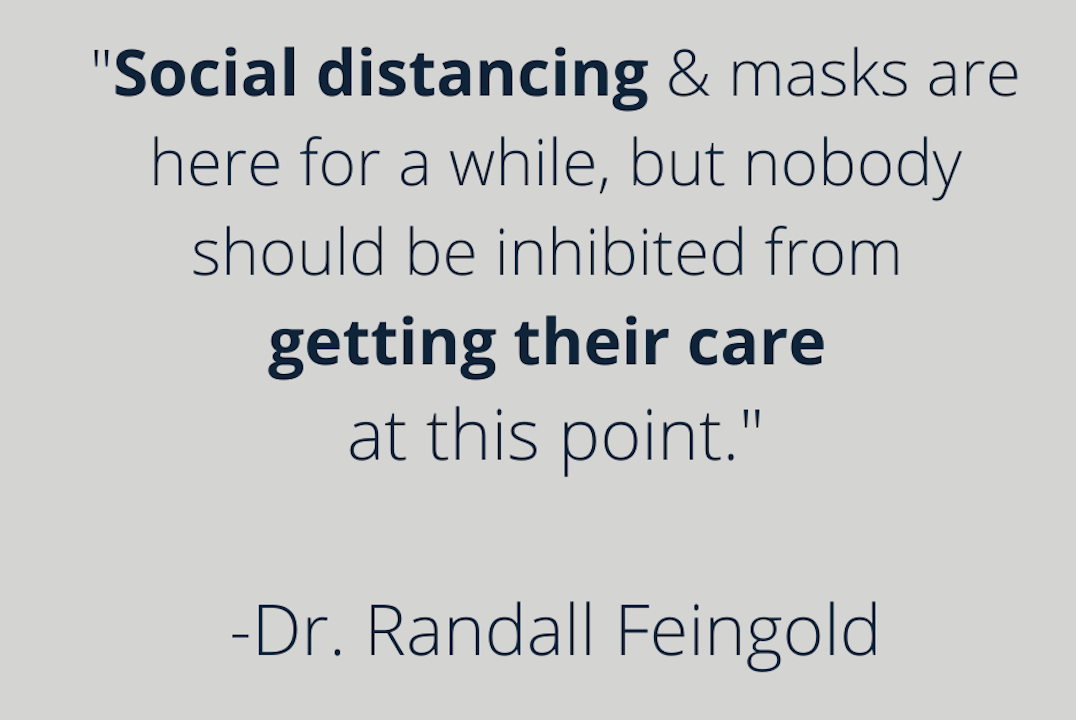Be Informed: Better COVID-19 Management Brings Back Hope—and Cancer Care
October 21, 2020
Dr. Randall Feingold began this month’s Be Informed Lecture, “Reasons To Be Cheerful: Improved COVID-19 Environment Allows Return of Cancer Care,” by taking stock of how far we’ve come since New York’s COVID’s peak.
“In March of 2020, our hospitals were overrun with COVID-19 patients. There was a cessation of treatment. Hope is a key thing in cancer care. I have to admit that I have never felt so helpless as a physician in 26 years of practice as I did at that time,” he said. “There is reason to be hopeful now; there have been many improvements, and there are reasons to be a little bit optimistic.”
Dr. Feingold acknowledged the many lives COVID has claimed, including those of three of his own physician colleagues, before he delved into where we are now and why hope—that key, cancer treatment ingredient—has finally returned.
The Overall Response to COVID-19 is Working
Our interventions are working. Social distancing, masks, and expanded testing and contact tracing, have allowed us to reopen services, healthcare, and schools. We understand the disease better now, we’re treating it differently, and research trials for therapy and vaccination are underway.
Disease Prevalence is Down
In New York, social distancing, masks and testing rapidly flattened the curve from a peak of 12,274 new daily cases on April 4 to below 1,000 new daily cases by June 7. Dr. Feingold reassured attendees that recent October hotspots were geographically understood and targeted for interventions. “I do not believe that those reflect a second, inevitable surge, but rather have happened in response to lack of compliance,” he said.
The Flu Season Looks Mild
There were concerns that the flu season would combine with COVID to overrun the healthcare system, but it turns out that flu and COVID prevention are very similar. Masks and social distancing declined the prevalence of influenza in the Southern Hemisphere, which suggests that “this may be the least prevalent flu season we see in our lifetimes.”
New York’s Positive Test Rate is Extremely Low
New York’s testing capacity now exceeds demand, so there’s no wait time for testing. Results are often turned around in as little as a day. Our positive test rate hovers at one-percent, the second lowest in the country. Hotspots that contain only six-percent of the state’s population account for 23-percent of those positive cases.
New Testing Methods Emerge Regularly
Gone are the days where only a nasopharyngeal swab could detect COVID-19. New testing methods—like testing cards, saliva tests, and rapid point of care testing machines—allow for wider access and different types of tests that better suit unique situations.
NYBRA is set to receive an Abbott ID Now, point of care nasal swab machine, which returns a result in 15 minutes. “Concerns that these machines are only 80% effective at picking up the virus are true, but according to statisticians, because the prevalence is so low, the chances of the test result being a true negative are 99%,” Dr. Feingold explained
Therapeutic Interventions are Better
Better disease comprehension means better treatment. Providers now use high flow oxygen to avoid placing patients on ventilators. Therapies like Remdesivir, famotidine, dexamethasone, anticoagulation drugs, Convalescent plasma, and recombinant antibodies (Regeneron) all improve patient outcomes.
Decline in COVID-19 Deaths
The New York State daily death rate hit its peak on April 7, with 1,036 lives lost in a single day. Current death rates hover at 10 to 15 per day.
Cancer Screening, Diagnosis and Treatment are Possible Again
Careful cleaning and staff screening procedures made it possible to safely open offices, outpatient centers, and hospitals. Office visits have resumed, though patient companions are limited. Telemedicine is available as needed.
Cancer and Reconstructive Surgeries are Back
Surgeries have resumed, meaning that newly diagnosed patients can have surgery scheduled as soon as required.
All surgical patients are tested for COVID-19 within five days before their operation. “I know of only one surgery in the practice where a patient had to be canceled because of COVID, and limited visitors are now allowed in hospitals.” As of this lecture, all of NYBRA’s backlogged reconstructive surgical cases had been completed.
Vaccine Development
There are four companies that are well into trials for a vaccine, and the government is already stockpiling vaccine supply chain items, like alcohol wipes and syringes. Dr. Feingold said he was optimistic that something would be available early next year.
An attendee asked how vaccines would be distributed. Dr. Feingold said he believed they would be rolled out at the state level, and that a plan was already in the works to protect elderly and vulnerable individuals, along with healthcare providers and first responders first.
As the discussion came to a close, Dr. Feingold reminded the group that we’ll need to stay the course for a strong finish. It’s important that we all continue to follow the protocols, like masks-wearing and handwashing, that have made it possible to restore safe, timely healthcare delivery. He also encouraged everyone to stay home if they felt ill and get vaccinated against the flu. “Social distancing and masks are here for a while, but nobody should be inhibited from getting their care at this point,” he said.
The Be Informed Lecture Series is held once/month as part of the Patient Empowerment Program. It focuses on topics that are relevant to both the practice’s breast cancer patients and those undergoing risk reducing mastectomy. For further information, contact Mollie Sugarman, Clinical Director/Patient Empowerment Program – Msugarman@nybra.com
Making Strides Against Breast Cancer 2020 Photo Gallery
The 2020 Making Strides on Long Island Drive Through Experience Event at Jones Beach on October 18, 2020.